My Takeaways From Animal Farm

"You should read Animal Farm..." was advise someone gave me a while back, that someone I now forget who they were. As I am someone who enjoys curling up with paper book - never an eBook - I often get such suggestions. However this one continued with, "... it's a short book, but don't let its size fool you." With a work trip earlier this year, I thought no time like the present to finally tap into this recommendation.
Animal Farm was written by George Orwell and published in 1945, four years before his most famous novel, 1984. It is the story of anthropomorphic animals on a farm who rise up against the humans who run the farm and proceed to take it over. Where I was always aware of the general premise of the story and that there was a cartoon movie made from the book, that was about it. My assumption that I thought it was more of a children's story was debunked quickly as I flew back to the US East Coast absorbing this page-turner of a story.
So what could I possibly takeaway from a book that featured talking pigs and horses?
To Russia with Disdain – The plot of Animal Farm, though satirical, is based on Orwell's perception and objection of Joseph Stalin and the Communist Soviet Union of that era. This was something I first learned of in the introduction of the book and not going into it. Where to some this may be considered a spoiler, it actually helped me frame the actions and behaviors of the farm animals as I traveled across the book’s pages.
Checks and balances – When power is centralized, there is the chance that little can be done to resist or change it. The same can be said for animals that act like people. Interestingly I think about this fact as much today when I read the news as I did when I read Animal Farm and was thinking about the time it was written.
Indoor and Outdoor talk – This concept cane from introduction of the book by author Tea Obreht when she was comparing 1940’s Soviet Union to when she grew up in 1980’s Yugoslavia. It literally refers to how people would talk about topics – mostly politics – differently inside their house and with family as compared to what they shared with others in the outside world. This of course harkens back to the oppressive governments in each of those times and places and how people would be turned in by neighbors for their resistance (or merely suspicion) to the government, usually to their ultimate demise.
Animal Farm is a very creative way to tell a story. Remove the fact that you are reading about farm animals, it is sad tale of human interaction. Add back in the animal element, and you have a tale that starts out jovial and encouraging but quickly turns sour.
I enjoyed reading Animal Farm and I recommend it to anyone as it is a classic with deep meaning. I decided to be in the moment when I finished it and left in the airplane's seat-back pocket, hoping serendipity would prevail and someone would notice and do as I did and read this classic, it’s lines and between them.
This is from The Hot Iron, a journal on business and technology by Mike Maddaloni.
Did you enjoy this? Subscribe to The Hot Iron by RSS/XML feed or Read by Email
Book Take-Aways • (0) Comments • PermalinkMy Takeaways From Strategic by Rich Horwath

All too often we get swept up in the minutiae of the work day and the next thing we know we are at home, plunked on the couch and say to ourselves, "Self, what the hell happened today?" When we then try to answer the question, we will find what we did was tactical and likely necessary, but was it the best solution or the best we can come up with, not to mention even remotely strategic?
One day being overcome with this feeling I was not being/acting strategic led me on a quest – where I may not be able to affect things surrounding me, I can try my damnedest to affect those in my three-foot world. So I did what anyone these days does when in a conundrum – I did a simple Internet search on the word “strategic.” Near the top of the results page was a link to the new book Strategic: The Skill to Set Direction, Create Advantage, and Achieve Executive Excellence by Rich Horwath. A Chicago-area consultant, he runs the Strategic Thinking Institute and is a speaker and consultant on strategy. From that description alone I felt like I struck gold, so I ordered a copy of the book right away.
When Strategic arrived I put aside the two other books I was simultaneously reading and dug into this, which I felt was a smart and – dare I say – strategic decision on my part. So it comes as no surprise I had a slew of takeaways from the book, and I will summarize some of the top ones here.
What strategic is and isn’t – The book opens with his definition of what strategic is: possessing insight that leads to advantage. Later he goes into details on what it is not: the ABC’s, aspiration, best practices and cautious. As the book flows, the topics discussed are built on these.
Strategy Quotient Assessment – Throughout the book there’s a plethora of models and tools to help you in analysis and decision-making that will lead to insight. One of them is the Strategic Quotient Assessment which is an online survey of 50 statements offered by the Strategic Thinking Institute to determine your strategic quotient, or SQ. As of this writing I have not yet taken it myself, but this assessment that comes with a cost is something I plan to do.
Note to Self: Read The Art of War – Several times in recent weeks I have seen references to this book that is over 2 millennia old and attributed to Chinese military strategist Sun Tzu. One of those was in this book. What’s interesting about these references is that in all cases they were related to business, not war. Needless to say it’s on my summer reading list.
Kill failing projects quickly – A quote in an article from Harvard Business Review on why execution of business strategy unravels in the book stated, and I am paraphrasing, if you decide to kill a failing project, do it right away and quickly.
When I read this I thought of the quote the great triad of Canadian philosophers, “if you choose not to decide you still have made a choice.” This phrase, now over 2 score old, reinforces something I have experienced over my career when leaders cannot decide to stop doing something soon enough, even when armed with the evidence needed to do so.
Don’t skip manager/staff meetings – To say we are overbooked with meetings is an understatement, and when looking to squeeze room into a packed calendar, often standing meetings with staff are canceled. Horwath stresses this should not be the case for a number of reasons that I, as someone who has been on the receiving end of this too often over the decades, completely concurs with. Remember, such one-on-one meetings should not be solely for the benefit of the staff person.
Strategic is a great read and packed with a number of decision-making models, advice and real-world experience from Horwath’s own consulting and coaching career and many well-known companies. Throughout it there are references to articles which are listed in the endnotes, which in itself is a great reading list that can provide you with a wealth of information in itself – I got a lot from the one I mentioned above and several others I read. The only critique I have of Strategic is that it uses business examples from well-known organizations like Amazon, but no names of small or mid-sized businesses, which may be relatable to the average reader. That being said, the points he used to reinforced with said company names were certainly not lost.
To say I recommend Strategic to anyone is a no-brainer. Whether you feel you are already strategic or tactical, a leader or staff worker, this book is for you. Where I typically give away books, this is one I am holding onto. It will be a reference and inspirational guide for myself to reread in part or whole to remind myself of what I need to be doing to not feel like I originally did when I sought out the book. This is also not Horwath’s only book as he has written several other books on strategy, including a strategy graphic novel. After going back in time and reading The Art of War, I may come back to present-day Earth and read some of these others.
Have you read Strategic? Have I inspired you to read it? I welcome your thoughts in the comments of this post.
This is from The Hot Iron, a journal on business and technology by Mike Maddaloni.
Did you enjoy this? Subscribe to The Hot Iron by RSS/XML feed or Read by Email
Book Take-Aways • Strategize • (2) Comments • PermalinkMy Takeaways From Rereading B2B Marketing Confessions
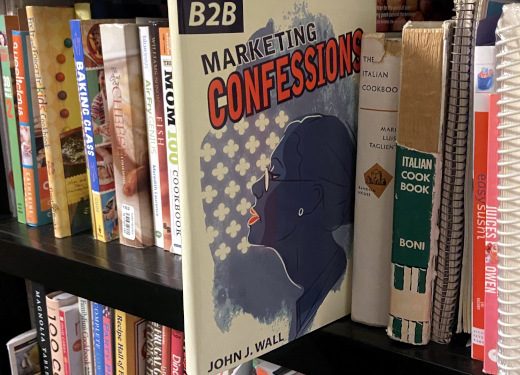
Timeless is a term that, when applied to something it indicates that no matter how old it is, the relevance and overall utilization of the item never diminishes. It's a term that can be applied to many things, including literature. A few timeless written works that come to mind include the Holy Bible, War and Peace and Atlas Shrugged among many.
Could B2B Marketing Confessions be added to that list?
I first read B2B Marketing Confessions shortly after it was published in 2011. Its author, John J. Wall, compiled his many years of traditional and digital marketing into an insider book that, despite its size, packs a ton of useful information and insight over his career to that point. As John is also lucky to know me personally, I held onto the book rather than giving it away. In the process of rearranging my desk to make room for other books I keep buying but never get to reading, I decided to revisit this book, over a dozen years after I first read it, especially as I realized I never wrote takeaways from it the first time. Oops.
With the timeless inference already out there, it may come as no surprise I still got a few takeaways from it today.
Solid marketing principals are timeless – Sure some of the names of specific tools are dated and HubSpot was nowhere then what it is now, but the types of tools and how you use them is still relevant today. Not to mention the hard, non-glamourous work that is behind the scenes in developing the marketing strategy.
Crossing the making-payroll chasm – This resonated to me, where the reference is regards to your business starts out as something where you just trying to eek by and concerned about making payroll, but then to take it to the next level you really need to invest and work hard to make it. Many business don’t get this far, and those that do still have a not-so-easy journey ahead.
Your CRM system won’t run itself – No truer words or thoughts can say this and it’s no different today than it was when this book was written. Any CRM system needs to be fully and properly administered, maintained, developed, governed and evaluated, let alone used properly by its end users.
Should the book be revised? – As John has written other books since and he shares his knowledge and research weekly as co-host of the long-running Marketing Over Coffee podcast, where I would vote for him to do it, I wouldn’t press him on it either.
B2B Marketing Confession flows from the product to how you market and sell it. Sprinkled throughout the book is John’s wit and anecdotes from the road, many I have had the good fortune to hear first-hand from him. I recommend this book for multiple categories of readers. It serves as a great reference for someone interested in marketing as a career, someone who doesn’t work in marketing but wants a better understanding of what they do, as well as those in the field who want to reflect on the profession. As you may guess I am going to hold onto my copy (I still need John to autograph it) however you can still find a copy online in print, digital and audio formats.
This is from The Hot Iron, a journal on business and technology by Mike Maddaloni.
Did you enjoy this? Subscribe to The Hot Iron by RSS/XML feed or Read by Email
Book Take-Aways • (0) Comments • PermalinkMy Takeaways From TekWar
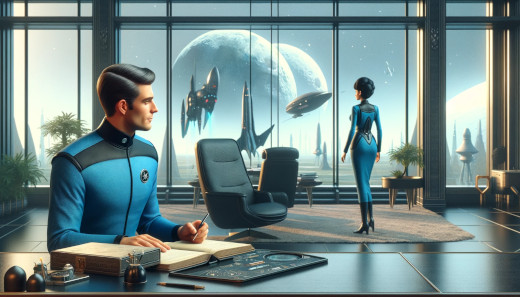
AI-generated image by DALL-E of someone writing a science fiction story
Not a day goes by when I don’t hear some comical reference to predictions that by 2020 we would have flying cars. Forecasting the future isn’t an exact science, but it can be fun to explore. Today some things are as they were predicted (like watch phones) and others are just not quite there yet (like living on the Moon).
What will life be like 100 years from? Will we finally have flying cars or something even better? Will we still have the societal problems today, will they go away or will be have completely new ones? All of this is explored in the science fiction book TekWar by William Shatner. Yes, the same William Shatner known for his role as Captain Kirk in the original Star Trek series, and beyond.
First published in 1989, TekWar is set in 2120. The hero of the novel is Jake Cardigan, a former police officer who is released from a futuristic prison early to work as a private investigator on a case. “Tek” is a futuristic illegal drug that got Jake in trouble and still plagues society. Where the technology of the time plays a key role in this story, it is the people and interactions with that technology that are core of the story.
But is it possible to have takeaways from the science fiction book? I sure did.
Did Shatner predict social media and print-on-demand books? – At one point in the story there’s mention about someone filming all the bad things in the city, and how it is presented sounded familiar to the livestreaming over social media that many – including myself – have done and continue to do. The concept of books printed on-demand, something that is a thriving business today, was presented in the story as done at the Dalton-Walden American Faxbook Centre (a nod to two now-defunct bookstore chains). Even android robots were able to print books from their abdomen.
The seedy side of life still exists – Where it would be nice to think that 100 years from now – or even in a shorter time period – the underbelly of society was reduced or eliminated. That wasn’t the case in TekWar, and my guess it won’t be when my descendants will be on this mortal coil.
Finally – There are flying cars in Shatner’s 2120, if that’s any comfort to you.
How I Learned About TekWar
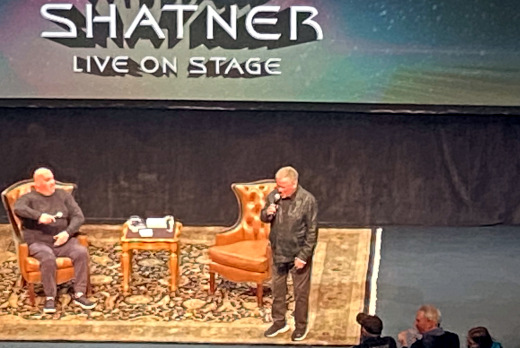
Last Fall William Shatner did a 5-city spoken word tour that kicked-off in none other than Appleton, Wisconsin, the city where I now call home. Why? I have no idea for sure, but the Fox Cities Performing Arts Center was the venue and was filled to about half-capacity for this unique show.
As it was in the midst of the actors and writers strikes, Shatner wasn’t even supposed to acknowledge any specific roles or characters he played by name. After a showing of the Star Trek II: The Wrath of Khan for which he was not “allowed” to even introduce, he took the stage for over 90 minutes of telling stories and answering some audience-submitted questions. At the young age of 92 on the night of the performance, he was not only animated and witty but an inspiration for anyone to be like him at that age, if we make it to that far.

Shatner was, however, able to talk about TekWar during his dialog, the first of a series of science fiction novels he wrote. As I previously was unaware he was a writer (I was aware of his “singing” career, but I digress) I had to get a copy of it. A few days later I bought a copy at a used bookstore not far from the theater I saw him at and brought it with me on a business trip. As I share all books I read, I decided to leave TekWar in the seatback pocket of the flight I was on when I finished reading it. Hopefully someone was able to find it and enjoy reading as I did about the trails, tribulations and travels in the future.
This is from The Hot Iron, a journal on business and technology by Mike Maddaloni.
Did you enjoy this? Subscribe to The Hot Iron by RSS/XML feed or Read by Email
Book Take-Aways • (0) Comments • PermalinkMy Takeaways From The Creative Act
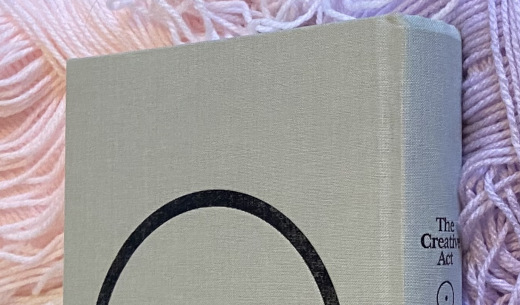
Are you creative? It’s a question that provokes different answers depending on who it is posed to. For some they would definitely have an answer to it, but for others they may wonder why it was asked of them in the first place. I have asked this of myself, someone who’s got his head down into a laptop computer most of his days doing whatever it takes to get through working in software technology. Then I will pull my head out of that laptop and look around me and remind myself that I am indeed creative.
Creativity comes in many forms, not just in output but in the process, or act. This is the theme of The Creative Act: A Way Of Being by Rick Rubin. Rubin is the legendary music producer who co-founded the Def Jam Recordings label and has worked with everyone from the Beastie Boys to Aerosmith to Johnny Cash and many, many others. Known for his eccentricity, last year he published this book of his thoughts on the creative process.
As I read through this unique book, I imagined how it possible came together: Rubin walking around his studio, barefoot, dictating his thoughts to someone following him around. Whether that was the case or not, his thoughts are presented in a unique way – there are dozens of “chapters” with some ranging from a couple of pages to more, but none too long. As I read through the book I was certainly inspired and had over a dozen significant takeaways, however I decided to refine the list to the following.
We all are artists – A pervasive theme throughout the book is that we are all artists. Often we think of artists as painters, photographers, writers, musicians... people who create things that are considered under the relatively rigid category of “art.” Often I sit back and look at a business or technical solution I have worked on for whatever time and even impress myself, finding a creative way to get from where I and my team are to where we want to be. Where nobody would be clamoring to have my work products from it framed and hung in a gallery, they have been deemed creative by others, so I would consider them art. I also consider myself creative with my time in improv and the writings here at this humble blog as ample examples.
Agile as art? – When I say “agile” I am referring to the philosophy/methods/approach/mindset of incrementally developing software and other products, often identified by frameworks such as Scrum and Kanban. With a goal in mind, a team of people are creating something, not necessarily knowing exactly what that finished product will look like. Where those on the team may not consider themselves artists or creative (nor others outside of a team looking at a bunch of business and tech types) this is not to say there is creativity and artistry in their work and process.
Ideas come from the outside, not the inside – This is an ethereal concept, where Rubin professes that ideas are out there, in the wild, and we recognize them and work with them. I’m not sure I completely agree with it, but he makes compelling points towards it. Perhaps the inspirations I would get when I walked along Lake Michigan in Chicago actually were in the air... along with the gnats buzzing around the shoreline?
Crafting – Rubin talks of how Andy Warhol did a lot of crafting, where he created an idea and had other artists execute on it. This triggered a pleasant flashback to 2006 when the Cloud Gate sculpture in Chicago’s Millennium Park was formally dedicated which I attended. During his speech the artist who created/crafted the artwork affectionately known as The Bean, Anish Kapoor, was repeatedly thanking the company Performance Structures, Inc. who took his idea and plans and actually built it. I just so happened to be in the crowd standing next to the president of the company, who was simultaneously blushing and beaming at the attention from Kapoor as he was pointing in our direction.
What is success to you? – Where many quotes from the book stirred something in me, this was especially did:
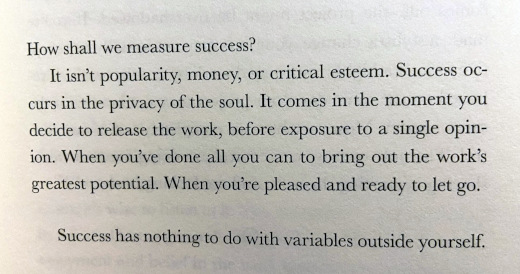
The quote reads as follows:
“How shall we measure success?
It isn't popularity, money, or critical esteem. Success occurs in the privacy of the soul. It comes in the moment you decide to release the work, before exposure to a single opinion. When you've done all you can to bring out the work's greatest potential. When you're pleased and ready to let go.
Success has nothing to do with variables outside yourself.”
When I have true success, I have felt this way. Do you agree?
“Comparison is the thief of joy” – This is a quote from the 26th US President Theodore Roosevelt, which is fitting from an individual there was really no comparison to in his lifetime.
I first learned of The Creative Act when I saw this video of Rick Rubin being interviewed by Anderson Cooper for 60 Minutes which is embedded below.
From my days in college radio I remember seeing Rubin’s name as the producer of many albums that came into the radio station. So last summer when on vacation and stopped into a locally-owned bookstore in northern Wisconsin and I saw the book in their collection, I had to buy it. I enjoyed it thoroughly, both in its format and collection of wisdom from a true modern guru. This is a book I recommend to everyone, whether you think you are creative or not (and if not, it may sway you). The destination for the giveaway of this book is a colleague and mentor who I feel is very creative in how he consults and educates... and I am pretty sure he concurs with my opinion.
This is from The Hot Iron, a journal on business and technology by Mike Maddaloni.
Did you enjoy this? Subscribe to The Hot Iron by RSS/XML feed or Read by Email
Book Take-Aways • (0) Comments • Permalink
